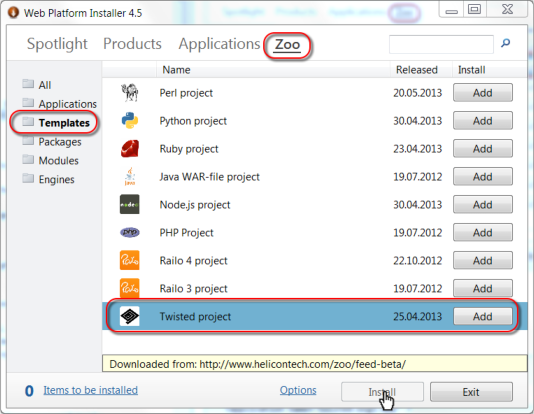Contents
Twisted
Installation
- Open Web Platform Installer and install "Python project":

Example wsgi.py
def application(environ, start_response):
start_response('200 OK', [('Content-type','text/html'),])
yield "<html><body>You requested <code>"
yield environ.get('PATH_INFO')
yield "</code></body></html>"Deployment
To deploy Python Tornado application you will need to install Python Hosting Package and Twisted on a target server. Then just copy IIS web site from one machine to another.
web.config example
<?xml version="1.0" encoding="UTF-8"?>
<configuration>
<system.webServer>
<heliconZoo>
<application name="twisted.wsgi.app" >
<environmentVariables>
<add name="PYTHONPATH" value="%APPL_PHYSICAL_PATH%;%APPL_PHYSICAL_PATH%\python_modules\Lib\site-packages;%PYTHONPATH%" />
<add name="WSGI_APP" value="wsgi.application" />
<add name="DEPLOY_FILE" value="deploy.py" />
<add name="DEPLOY_LOG" value="log\deploy.log" />
</environmentVariables>
</application>
</heliconZoo>
<handlers>
<add name="twisted.wsgi.app#x86" scriptProcessor="python.2.7.twisted"
path="*" verb="*" modules="HeliconZoo_x86" preCondition="bitness32"
resourceType="Unspecified" requireAccess="Script" />
<add name="twisted.wsgi.app#x64" scriptProcessor="python.2.7.twisted"
path="*" verb="*" modules="HeliconZoo_x64" preCondition="bitness64"
resourceType="Unspecified" requireAccess="Script" />
</handlers>
</system.webServer>
</configuration>Environment variables
-
PYTHONPATH— path to Python modules. In the example it points to application root, the python_modules\Lib\site-packages subfolder and also includes value defined by user. -
WSGI_APP— full path to the application’s entry point function. -
WATCH_FILE_CHANGES_MASK— files to watch. Worker is restarted every time a file of specified type changes. In the example all.pyfiles are watched.
deploy.py file example
Deploy file is used to execute commands, such as components installations or database migrations, on a server when the application initially starts or updated. The following code is only an example. We recommend you to use deploy.py file that comes with the Python project template.
# This file is example of deploy.py
# The file is executed once on the first request after every restart of IIS application.
# The file output is redirected to log file described in DEPLOG_LOG environment variable.
import sys
import os
import os.path
PROJECT_DIR = os.path.dirname(__file__)
os.chdir(PROJECT_DIR)
PIP_EXE = os.path.join(os.path.dirname(sys.executable), 'scripts\\pip.exe')
# update APPDATA env for pip
os.environ['APPDATA'] = os.path.join(PROJECT_DIR, 'python_modules')
# install requirements to local folder
os.system('{0} install --install-option="--prefix={1}" --requirement=requirements.txt'.format(PIP_EXE, os.path.join(PROJECT_DIR, 'python_modules')))